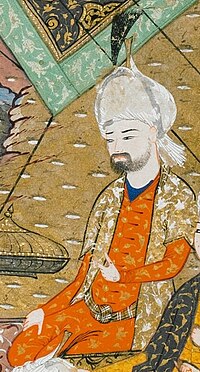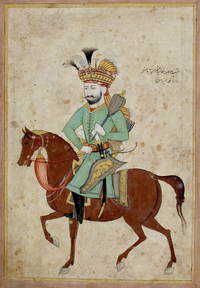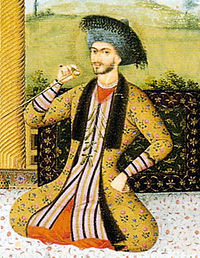Following table consists name of Safavid dynasty monarchs in Iran.
List of Safavid monarchs
| Portrait | Titular Name | Full Name | Birth | Reign | Death | Notes |
|---|---|---|---|---|---|---|

|
Ismail I اسماعیل یکم |
Abu’l Muzaffar Shah Ismail al-Husayni al-Musavi al-Safavi Bahadur Khan ابوالمظفر شاه اسمعیل الحسینی الموسوی الصفوی بهادرخان |
17 July 1487 Ardabil, Iran |
22 December 1501 – 23 May 1524 | 23 May 1524 (aged 36) Near Tabriz, Iran |
Founded the dynasty. Formation of the first central government after the Arab invasion of Iran. Selecting Tabriz as the capital. Declaring Shiism as the official religion of the government. Victory in the war against the Uzbeks at 1510. Defeat in the Battle of Chaldiran |

|
Tahmasp I تهماسب یکم |
Abu’l Muzaffar Abu’l Fath Shah Tahmasp al-Husayni al-Musavi al-Safavi Bahadur Khan ابوالمظفر ابوالفتح شاه تهماسب الحسینی الموسوی الصفوی بهادر خان |
22 February 1514 Shahabad, Isfahan, Iran |
23 May 1524 – 25 May 1576 | 25 May 1576 (aged 62) Qazvin, Iran |
Victory over the Uzbeks. Consecutive defeats in the war with the Ottoman empire. The conclusion of the Treaty of Amasya with the Ottoman Empire, under which; Western Georgia, Western Armenia, and parts of present-day Iraq were ceded to the Ottoman government. Asylum of Humayun Shah and Şehzade Bayezid to the court of Iran. Change the capital of safavid dynasty from Tabriz to Qazvin |

|
Ismail II اسماعیل دوم |
Abu’l Muzaffar Shah Ismail II al-Husayni al-Musavi al-Safavi Bahadur Khan ابوالمظفر شاه اسمعیل ثانی الحسینی الموسوی الصفوی بهادر خان |
31 May 1537 Qom, Iran |
22 August 1576 – 24 November 1577 | 24 November 1577 (aged 40) Qazvin, Iran |
With the help of the Qezelbash. he wins the race for succession over his brother Haidar Mirza. As soon as he came to power, he killed all his uncles, cousins, brothers and nephews (his older brother Mohammad Mirza, the ruler of Fars, and his sons like Abbas Mirza, who survived the massacre).
Ishmael II has the shortest reign among all Safavid kings, he reigned for 1 year, 6 months and 22 days |

|
Mohammad Khodabanda محمد خدابنده |
Abu’l Muzaffar Shah Sultan Mohammad al-Husayni al-Musavi al-Safavi Bahadur Khan ابوالمظفر شاه سلطان محمد الحسینی الموسوی الصفوی بهادر خان |
1532 ? |
11 February 1578 – October 1587 | 1595 (aged 64) Alamut Castle, Qazvin, Iran |
It is ruled by the rulers of qezelbash. Defeat in the war with the Ottoman Empire and the secession of the Caucasus, Armenia and Azerbaijan from Iran. Mohammad Khodabandeh was defeated by the Uzbeks in 1585, which led to the secession of Khorasan province from Iran (in the same year, the Uzbeks destroyed the tomb of Shah Tahmasp and removed his bones and set it on fire). In successive battles for the throne with his son abbas mirza, He was defeated in a series of battles with his son and was imprisoned in Alamut Castle for the rest of his life. |

|
Abbas I عباس یکم |
Abu’l Muzaffar Shah Abbas al-Husayni al-Musavi al-Safavi Bahadur Khan ابوالمظفر شاه عباس الحسینی الموسوی الصفوی بهادر خان |
27 January 1571 Herat, Safavid Iran (modern-day Afghanistan) |
1 October 1588 – 19 January 1629 | 19 January 1629 (aged 57) Ashraf, Iran |
He came to the throne with the help of qezelbash rulers. Early peace with the Ottoman Empire and buying time to reorganize the government and the army. Moved the capital of the Safavid dynasty from Qazvin to Isfahan. Attack on Uzbeks and retook lost territories during the reign of Shah sultan Mohammad Khodabanda. Attacks on the Ottoman Empire and the recapture of Tabriz, Urmia, Armenia and the conquest of Tbilisi, Iraqi Kurdistan and Baghdad. Recapture of Kandahar from Mughal empires. Invasion of Hormuz with English help and expulsion of the Portuguese from southern Iran. |

|
Safi I صفی یکم |
'Abu’l Muzaffar Safi Shah al-Husayni al-Musavi al-Safavi Bahadur Khan ابوالمظفر صفی شاه الحسینی الموسوی الصفوی بهادر خان |
1611 ? |
28 January 1629 – 12 May 1642 | 12 May 1642 (aged 30/31) Kashan, Iran |
Killing all the rulers of Shah Abbas and killing and blinding the whole royal family. Loss of the states of Baghdad and Kandahar. Peace with the Ottoman Empire and the conclusion of the Treaty of Zuhab between the parties and With the conclusion of this treaty, there was no war between the two countries until the end of the Safavid rule. |

|
Abbas II عباس دوم |
'Abu’l Muzaffar Shah Abbas II al-Husayni al-Musavi al-Safavi Bahadur Khan ابوالمظفر شاه عباس ثانی الحسینی الموسوی الصفوی بهادر خان |
30 August 1632 Qazvin/Isfahan, Iran |
15 May 1642 – 26 October 1666 | 26 October 1666 (aged 34) Khosrowabad, near Damghan, Iran |
In 1643 Rostam Khan and in 1644 the Bakhtiari tribes revolted, but both revolts were suppressed by Saru Taqi. On February 22, 1649, Kandahar was re-occupied by the Safavids. The city remained part of the Safavid kingdom until the fall of Isfahan. The Iran-Russia Wars (1551–1553) took place, neither side gained complete supremacy. However, after this period of wars, Safavids influence in the northern parts of the Caucasus was strengthened. |

|
Suleiman I/Safi II سلیمان یکم/صفی دوم |
'Abu’l Muzaffar Shah Suleiman al-Husayni al-Musavi al-Safavi Bahadur Khan ابوالمظفر شاه سلیمان الحسینی الموسوی الصفوی بهادر خان |
February/March 1648 or 1647 ? |
1 November 1666 – 29 July 1694 | 29 July 1694 (aged 46) Isfahan, Iran |
He was crowned twice, first crowned by name of Safi II on November 1, 1666, and second crowned by name of Shah Suleiman on March 20, 1668. During his first coronation, tribes east of the Caspian Sea revolted, including the Cossacks, who invaded Iran by sea and burned the city of Farahabad, killing people and occupying part of the country. Government administration by Prime Minister Shaykh Ali Khan Zanganeh and increasing the influence of pilgrims and women of the shrine. Increasing ties with European governments and many constructions in the country, including the construction of Hasht Behesht. |

|
Sultan Husayn سلطان حسین |
'Abu’l Muzaffar Shah Sultan Husayn al-Husayni al-Musavi al-Safavi Bahadur Khan ابوالمظفر شاه سلطان حسین الحسینی الموسوی الصفوی بهادر خان |
October 1668 ? |
6 August 1694 – 21 October 1722 | 15 November 1726 (aged 58) Isfahan, Iran |
Increasing the influence of Shiite clerics such as Allameh Majlisi and being too strict with other religions. Insurgency of Afghans (Ghaljai and Abdali), Baluchis, Kurds and Lezgi tribes throughout Iran. Mahmud Afghan invaded in 1720 to overthrow the central government
The fall of Kerman province in 1721. Sending Tahmasp Mirza to Qazvin and Safi Mirza to Kermanshah before the fall of the capital to help the central government. Siege of Isfahan from March 8, 1722, by Mahmud Afghan, surrender of the throne in October 1722 to Mahmud Afghan and the fall of the Safavid dynasty. He was executed by order of Ashraf Afghan on November 15, 1726. |
See also
References
- Ismāʿīl I, in Encyclopædia Britannica, online ed., 2011
- Woodbridge Bingham, Hilary Conroy, Frank William Iklé, A History of Asia: Formations of Civilizations, From Antiquity to 1600,and Bacon, 1974, p. 116.
- "ṬAHMĀSP I". Retrieved 12 May 2015.
- Shaw, Stanford J. (1976), History of the Ottoman Empire and modern Turkey, Volume 1, p. 109. Cambridge University Press, ISBN 0-521-29163-1
- Ismail II , Dr Manouchehr Parsadoost, ISBN 9643251063, 2003
- Andrew J. Newman, Safavid Iran (IB Tauris, 2004) p. 42
- Oberling, Pierre, Georgians and Circassians in Iran, The Hague, 1963; pp.127-143
- Savory pp. 69–70
- Matthee, Rudi (28 July 2008), Safavid Dynasty, retrieved 9 August 2012
- Andrew J. Newman, Safavid Iran, I.B.Tauris, 2004, p.42
- Thorne 1984, p. 1
- Savory 1980, p. 71
- Newman 2006, p. 42
- fa:شاه صفی یکم
- Babaie et al. 2004, p. 44
- fa:شاه سلیمان یکم
- Sultan Husayn
Sources
- Babaie, Sussan; Babayan, Kathryn; Baghdiantz-MacCabe, Ina; Farhad, Mussumeh (2004). Slaves of the Shah: New Elites of Safavid Iran. Library of Middle East History. London: I. B. Tauris. ISBN 9781788310864.
- Newman, Andrew J. (2006). Safavid Iran: Rebirth of a Persian Empire. Library of Middle East History. London, UK: I. B. Tauris. ISBN 1-86064-667-0.
- Savory, Roger M. (1980). Iran under the Safavids. Cambridge, UK: Cambridge University Press. ISBN 0-521-22483-7. LCCN 78073817.
- Thorne, John O., ed. (1984). "Abbas I". Chambers Biographical Dictionary. Edinburgh, UK: Chambers Harrap. ISBN 0-550-18022-2. LCCN 2010367095.